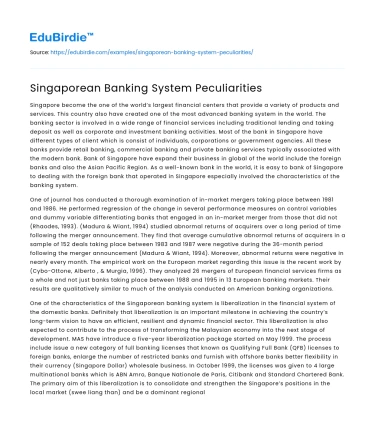Singapore become the one of the world’s largest financial centers that provide a variety of products and services. This country also have created one of the most advanced banking system in the world. The banking sector is involved in a wide range of financial services including traditional lending and taking deposit as well as corporate and investment banking activities. Most of the bank in Singapore have different types of client which is consist of individuals, corporations or government agencies. All these banks provide retail banking, commercial banking and private banking services typically associated with the modern bank. Bank of Singapore have expand their business in global of the world include the foreign banks and also the Asian Pacific Region. As a well-known bank in the world, it is easy to bank of Singapore to dealing with the foreign bank that operated in Singapore especially involved the characteristics of the banking system.
One of journal has conducted a thorough examination of in-market mergers taking place between 1981 and 1986. He performed regression of the change in several performance measures on control variables and dummy variable differentiating banks that engaged in an in-market merger from those that did not (Rhaodes, 1993). (Madura & Wiant, 1994) studied abnormal returns of acquirers over a long period of time following the merger announcement. They find that average cumulative abnormal returns of acquirers in a sample of 152 deals taking place between 1983 and 1987 were negative during the 36-month period following the merger announcement (Madura & Wiant, 1994). Moreover, abnormal returns were negative in nearly every month. The empirical work on the European market regarding this issue is the recent work by (Cybo-Ottone, Alberto , & Murgia, 1996). They analyzed 26 mergers of European financial services firms as a whole and not just banks taking place between 1988 and 1995 in 13 European banking markets. Their results are qualitatively similar to much of the analysis conducted on American banking organizations.
Save your time!
We can take care of your essay
- Proper editing and formatting
- Free revision, title page, and bibliography
- Flexible prices and money-back guarantee
One of the characteristics of the Singaporean banking system is liberalization in the financial system of the domestic banks. Definitely that liberalization is an important milestone in achieving the country’s long-term vision to have an efficient, resilient and dynamic financial sector. This liberalization is also expected to contribute to the process of transforming the Malaysian economy into the next stage of development. MAS have introduce a five-year liberalization package started on May 1999. The process include issue a new category of full banking licenses that known as Qualifying Full Bank (QFB) licenses to foreign banks, enlarge the number of restricted banks and furnish with offshore banks better flexibility in their currency (Singapore Dollar) wholesale business. In October 1999, the licenses was given to 4 large multinational banks which is ABN Amro, Banque Nationale de Paris, Citibank and Standard Chartered Bank. The primary aim of this liberalization is to consolidate and strengthen the Singapore’s positions in the local market (swee liang than) and be a dominant regional financial center. The chairman of the central bank, the Monetary Authority of Singapore (MAS) Lee Hsien Long (2001) notes that “…being big is no guarantee for success, as shown by the persistent difficulties of the Japanese banks over the last decade … But being a small bank is definitely a significant handicap”. This look like to recommend that the government feared the domestic banks that cannot endure the niche players, sizeable in the domestic market, even small by the international standards. Through this liberalization, the bank of Singapore sought to maintain the local ownership of banks. Furthermore, the existing cap of 40% of foreign ownership of local bank was maintained. Start in June 2001, the second phase of liberalization which is the restricted banks were classified bank as wholesale banks to improve competitiveness in retail banking. QFB were given more authorizations to establish more location, offer debt and special account services. Specifically, this liberalization has bring about main changes in the local banking scene.
Another features that manages to a clearly boundary for foreign banks to operate in Singapore in banking system is merger and acquisition. Bank of Singapore strengthen their local bank geographical presence through the merger and acquisition. The merger represents a transaction in which two companies agree to unify their operations relatively fairly because they have the resources and ability to create strong competitive advantage. A merger of two or more companies, generally by offering a shareholder a trustee in a company that is taking over in exchange for the surrender of their shares meanwhile acquisitions is a transaction in which one firm buys another firm with the intention of becoming more efficient using its core competencies by making the firm a subsidiary in its business portfolio or it is a obtaining to another company. Started in November 1998, bank of Singapore has bought cash-rich Post Office Savings Banks (POSB) from the Singapore Government for $1.6 billion, approximately 37% premium over POSB’s net tangible asset value, consolidating the DBS bank’s position as Southest Asia’s largest bank and the largest retail bank in Singapore. Meanwhile, in January 1998, DBS announced the acquisition of 50.3% of Thai Danu bank, for $182.34 million and having acquired a 3 % stake in 1989. In addition, on 11 April 2011, DBS has buy Hong Kong’s Dao Heng Bank for $10 billion in order to launch itself into a area powerhouse. The expected can gain from this is hoping instant diversification of business especially on asset and revenue side. Besides, it can be a platform for expanding into China.






 Stuck on your essay?
Stuck on your essay?

